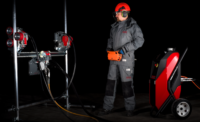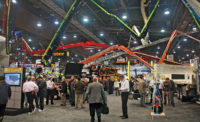Nervous chatter about supply chain constraints and uncertainty about the post-COVID era was virtually absent among the nearly 60,000 contractors, manufacturers and assorted masonry experts at the World of Concrete held Jan. 23 to 25 in Las Vegas. Equipment makers were filling order books and firms were looking to refresh and expand their fleets as the big spending from recent federal infrastructure initiatives begins to translate into real projects. The atmosphere was upbeat, even as private sector work faces some economic headwinds.
“With a stronger economy than expected, inflation doesn’t come down as fast, and neither do interest rates and those sectors—residential and nonresidential [sectors] get hurt,” said Ed Sullivan, chief economist for the Portland Cement Association. “But other sectors not sensitive to interest rates, like infrastructure spending, [are] expected to show up in a more meaningful way this year and next,” he said, adding that a revitalized U.S. manufacturing sector—buoyed by the 2022 CHIPS and Science Act—is another bright spot for construction.
Caterpillar's new CTL 265 features a redesigned cab intended to make long shifts a bit more comfortable. It is able to handle high-demand hydraulic attachments, such as the PC306 mulcher.
Photo by Jeff Rubenstone
While PCA noted a decline in cement consumption of 2.9% last year, things are looking up slightly this year, with a forecasted rise of 1.4%. “In our mind, the additional adverse impact coming from high interest rates is partially offset by the stronger economic conditions," explained Sullivan, during a press briefing.
More Comfortable Cabs
On the show floor, there was a renewed sense among attendees that with supply chain issues mostly sorted and manufacturing up and running, new machines could be delivered promptly this year. For Caterpillar, there was a lot of attention and buzz around its new compact track loaders, the medium chassis 255 and the larger 265. The models have automatic tool attachment recognition and an operator’s cab with greater creature comfort.
The new cab design is "driven by the shortage of workers—if you can attract good talent and you want to retain them, one of the ways to do that is to provide them with good equipment that performs but is also comfortable to be in,” says Kevin Coleman, product manager at Caterpillar.
With redesigned hydraulics allowing the loaders to run larger tool attachments and power through more difficult tasks, the loader has been slowly shifting from a hop-in, hop-out piece of equipment to one where the operator may spend an entire shift. Caterpillar also is bringing features previously seen on larger machine cabs, such as optional ventilated seats with heat and air suspension, as well as rear-view and side-view cameras, to its smaller equipment.
The 255 and 265 models feature 64-hp engines—to stay below threshold for emissions after-treatment—but their modern hydraulic systems allow them to run some of the most demanding attachments, including mulchers and other power-hungry forestry equipment. Both have lift heights of 11 ft, allowing for loading into higher trucks.
A New Era of the Battery Wars
Recent innovations pushing the limits of lithium-ion power have seen battery-powered tools tackling many applications formerly powered with cords or gas.
New battery lines from Milwaukee Tool and DeWalt were on display and available for demonstrations on the show floor, with concrete rammers, concrete vibrators and concrete cut-off saws running off new battery platforms. The batteries can last the whole shift.
Milwaukee’s new MX FUEL REDLITHIUM FORGE batteries bring longer runtime and extra power for more demanding applications. “What’s really unique about these is they’re really pushing the limits of capacity,” explains Kelli Semon, product manager for Milwaukee Tool.
Also new at the show was Milwaukee’s new Supercharger for the FORGE batteries, allowing two batteries to be charged at the same time off a standard 15-Amp circuit. Using Milwaukee’s OneKey Bluetooth access, the battery charger's behavior can be adjusted by a smartphone, allowing even more battery chargers to charge, albeit more slowly, off a single 15-Amp circuit without tripping a breaker. This flexibility allows for quicker charging of a battery or two during a single shift, while more batteries can be charged overnight in a tool crib, Semon says.
Photo by Jeff Rubenstone
One of the most demanding applications is the new MX FUEL 70kg Rammer, which runs on the new FORGE HD12.0 battery, delivering up to 25 minutes of continuous runtime. A tool that usually requires gas power, the 70kg Rammer also features a gyroscopic automatic shutoff, instantly turning off the machine if it tips beyond a certain angle.
Meanwhile, DeWalt debuted its rechargeable Powershift line of 554 Wh batteries and accompanying cordless concrete tools at World of Concrete. Each battery weighs 11.5 lbs. Heavier than a battery for hand tools, it is sized to fit nicely in concrete tools, such as screeds and concrete vibrators. DeWalt also had a new high-rate charger that can recharge the 554 Wh battery in less than one hour. Its product team said two batteries could effectively replace one tank of gasoline for powering such tools.
Photo by Jeff Rubenstone
Richard Cacchiotti, director of product management for the DeWalt line at Stanley Black & Decker, said 15,000 sq ft to 18,000 sq ft can be smoothed using one screed with one battery and the backpack vibrator in the line can consolidate concrete for four to five hours on one battery. DeWalt also showed an adapter that allows the 20-60-V DeWalt Flexvolt batteries to be used in the 60V.
DeWalt is not focusing on the capacity of the batteries but, rather, the work rate of them. 554 Wh makes for a 9.2 Ah pack. The most powerful Flexvolt battery pack available now is 300 Wh/5Ah (15Ah at 20V Max), which makes the PowerShift pack an 85% increase in capacity. DeWalt expects the new batteries and tools to be available this fall.
By Jeff Rubenstone in Las Vegas, with Jeff Yoders






